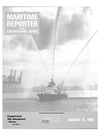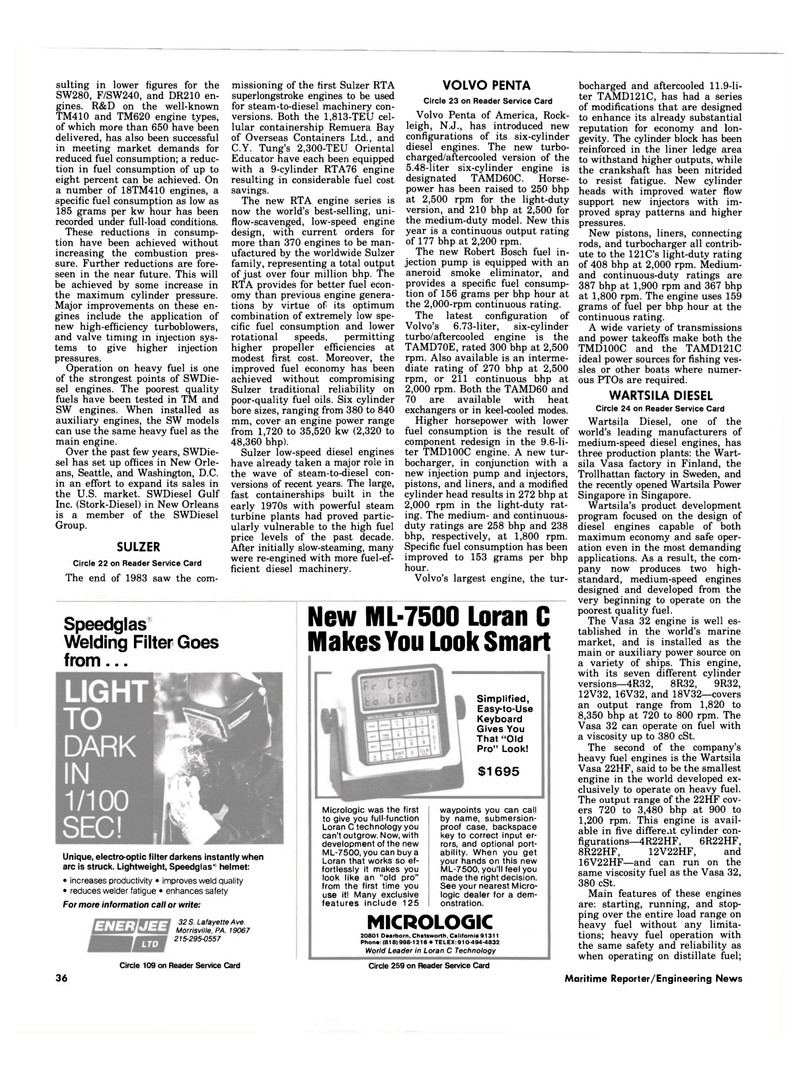
Page 34: of Maritime Reporter Magazine (January 15, 1985)
Read this page in Pdf, Flash or Html5 edition of January 15, 1985 Maritime Reporter Magazine
suiting in lower figures for the
SW280, F/SW240, and DR210 en- gines. R&D on the well-known
TM410 and TM620 engine types, of which more than 650 have been delivered, has also been successful in meeting market demands for reduced fuel consumption; a reduc- tion in fuel consumption of up to eight percent can be achieved. On a number of 18TM410 engines, a specific fuel consumption as low as 185 grams per kw hour has been recorded under full-load conditions.
These reductions in consump- tion have been achieved without increasing the combustion pres- sure. Further reductions are fore- seen in the near future. This will be achieved by some increase in the maximum cylinder pressure.
Major improvements on these en- gines include the application of new high-efficiency turboblowers, and valve timing in injection sys- tems to give higher injection pressures.
Operation on heavy fuel is one of the strongest points of SWDie- sel engines. The poorest quality fuels have been tested in TM and
SW engines. When installed as auxiliary engines, the SW models can use the same heavy fuel as the main engine.
Over the past few years, SWDie- sel has set up offices in New Orle- ans, Seattle, and Washington, D.C. in an effort to expand its sales in the U.S. market. SWDiesel Gulf
Inc. (Stork-Diesel) in New Orleans is a member of the SWDiesel
Group.
SULZER
Circle 22 on Reader Service Card
The end of 1983 saw the com- missioning of the first Sulzer RTA superlongstroke engines to be used for steam-to-diesel machinery con- versions. Both the 1,813-TEU cel- lular containership Remuera Bay of Overseas Containers Ltd., and
C.Y. Tung's 2,300-TEU Oriental
Educator have each been equipped with a 9-cylinder RTA76 engine resulting in considerable fuel cost savings.
The new RTA engine series is now the world's best-selling, uni- flow-scavenged, low-speed engine design, with current orders for more than 370 engines to be man- ufactured by the worldwide Sulzer family, representing a total output of just over four million bhp. The
RTA provides for better fuel econ- omy than previous engine genera- tions by virtue of its optimum combination of extremely low spe- cific fuel consumption and lower rotational speeds, permitting higher propeller efficiencies at modest first cost. Moreover, the improved fuel economy has been achieved without compromising
Sulzer traditional reliability on poor-quality fuel oils. Six cylinder bore sizes, ranging from 380 to 840 mm, cover an engine power range from 1,720 to 35,520 kw (2,320 to 48,360 bhp).
Sulzer low-speed diesel engines have already taken a major role in the wave of steam-to-diesel con- versions of recent years. The large, fast containerships built in the early 1970s with powerful steam turbine plants had proved partic- ularly vulnerable to the high fuel price levels of the past decade.
After initially slow-steaming, many were re-engined with more fuel-ef- ficient diesel machinery.
VOLVO PENTA
Circle 23 on Reader Service Card
Volvo Penta of America, Rock- leigh, N.J., has introduced new configurations of its six-cylinder diesel engines. The new turbo- charged/aftercooled version of the 5.48-liter six-cylinder engine is designated TAMD60C. Horse- power has been raised to 250 bhp at 2,500 rpm for the light-duty version, and 210 bhp at 2,500 for the medium-duty model. New this year is a continuous output rating of 177 bhp at 2,200 rpm.
The new Robert Bosch fuel in- jection pump is equipped with an aneroid smoke eliminator, and provides a specific fuel consump- tion of 156 grams per bhp hour at the 2,000-rpm continuous rating.
The latest configuration of
Volvo's 6.73-liter, six-cylinder turbo/aftercooled engine is the
TAMD70E, rated 300 bhp at 2,500 rpm. Also available is an interme- diate rating of 270 bhp at 2,500 rpm, or 211 continuous bhp at 2,000 rpm. Both the TAMD60 and 70 are available with heat exchangers or in keel-cooled modes.
Higher horsepower with lower fuel consumption is the result of component redesign in the 9.6-li- ter TMD100C engine. A new tur- bocharger, in conjunction with a new injection pump and injectors, pistons, and liners, and a modified cylinder head results in 272 bhp at 2,000 rpm in the light-duty rat- ing. The medium- and continuous- duty ratings are 258 bhp and 238 bhp, respectively, at 1,800 rpm.
Specific fuel consumption has been improved to 153 grams per bhp hour.
Volvo's largest engine, the tur-
Speedglas
Welding Filter Goes from...
Unique, electro-optic filter darkens instantly when arc is struck. Lightweight, Speedglas" helmet: • increases productivity • improves weld quality • reduces welder fatigue • enhances safety
For more information call or write: 32 S. Lafayette Ave.
Morrisville, PA. 19067 215-295-0557
New ML-7500 Loran C Makes You Look Smart
Micrologic was the first to give you full-function
Loran C technology you can't outgrow. Now, with development of the new
ML-7500, you can buy a
Loran that works so ef- fortlessly it makes you look like an "old pro" from the first time you use it! Many exclusive features include 125
Simplified,
Easy-to-Use
Keyboard
Gives You
That "Old
Pro" Look! $1695 waypoints you can call by name, submersion- proof case, backspace key to correct input er- rors, and optional port- ability. When you get your hands on this new
ML-7500, you'll feel you made the right decision.
See your nearest Micro- logic dealer for a dem- onstration.
MICROLOGIC 20801 Dearborn, Chatsworth, California 91311
Phone: (818) 998-1216 • TELEX: 910-494-4832
World Leader in Loran C Technology
Circle 109 on Reader Service Card Circle 259 on Reader Service Card 36 bocharged and aftercooled 11.9-li- ter TAMD121C, has had a series of modifications that are designed to enhance its already substantial reputation for economy and lon- gevity. The cylinder block has been reinforced in the liner ledge area to withstand higher outputs, while the crankshaft has been nitrided to resist fatigue. New cylinder heads with improved water flow support new injectors with im- proved spray patterns and higher pressures.
New pistons, liners, connecting rods, and turbocharger all contrib- ute to the 121C's light-duty rating of 408 bhp at 2,000 rpm. Medium- and continuous-duty ratings are 387 bhp at 1,900 rpm and 367 bhp at 1,800 rpm. The engine uses 159 grams of fuel per bhp hour at the continuous rating.
A wide variety of transmissions and power takeoffs make both the
TMD100C and the TAMD121C ideal power sources for fishing ves- sles or other boats where numer- ous PTOs are required.
WARTS I LA DIESEL
Circle 24 on Reader Service Card
Wartsila Diesel, one of the world's leading manufacturers of medium-speed diesel engines, has three production plants: the Wart- sila Vasa factory in Finland, the
Trollhattan factory in Sweden, and the recently opened Wartsila Power
Singapore in Singapore.
Wartsila's product development program focused on the design of diesel engines capable of both maximum economy and safe oper- ation even in the most demanding applications. As a result, the com- pany now produces two high- standard, medium-speed engines designed and developed from the very beginning to operate on the poorest quality fuel.
The Vasa 32 engine is well es- tablished in the world's marine market, and is installed as the main or auxiliary power source on a variety of ships. This engine, with its seven different cylinder versions—4R32, 8R32, 9R32, 12V32, 16V32, and 18V32—covers an output range from 1,820 to 8,350 bhp at 720 to 800 rpm. The
Vasa 32 can operate on fuel with a viscosity up to 380 cSt.
The second of the company's heavy fuel engines is the Wartsila
Vasa 22HF, said to be the smallest engine in the world developed ex- clusively to operate on heavy fuel.
The output range of the 22HF cov- ers 720 to 3,480 bhp at 900 to 1,200 rpm. This engine is avail- able in five different cylinder con- figurations—4R22HF, 6R22HF, 8R22HF, 12V22HF, and 16V22HF—and can run on the same viscosity fuel as the Vasa 32, 380 cSt.
Main features of these engines are: starting, running, and stop- ping over the entire load range on heavy fuel without any limita- tions; heavy fuel operation with the same safety and reliability as when operating on distillate fuel;
Maritime Reporter/Engineering News

 33
33

 35
35
